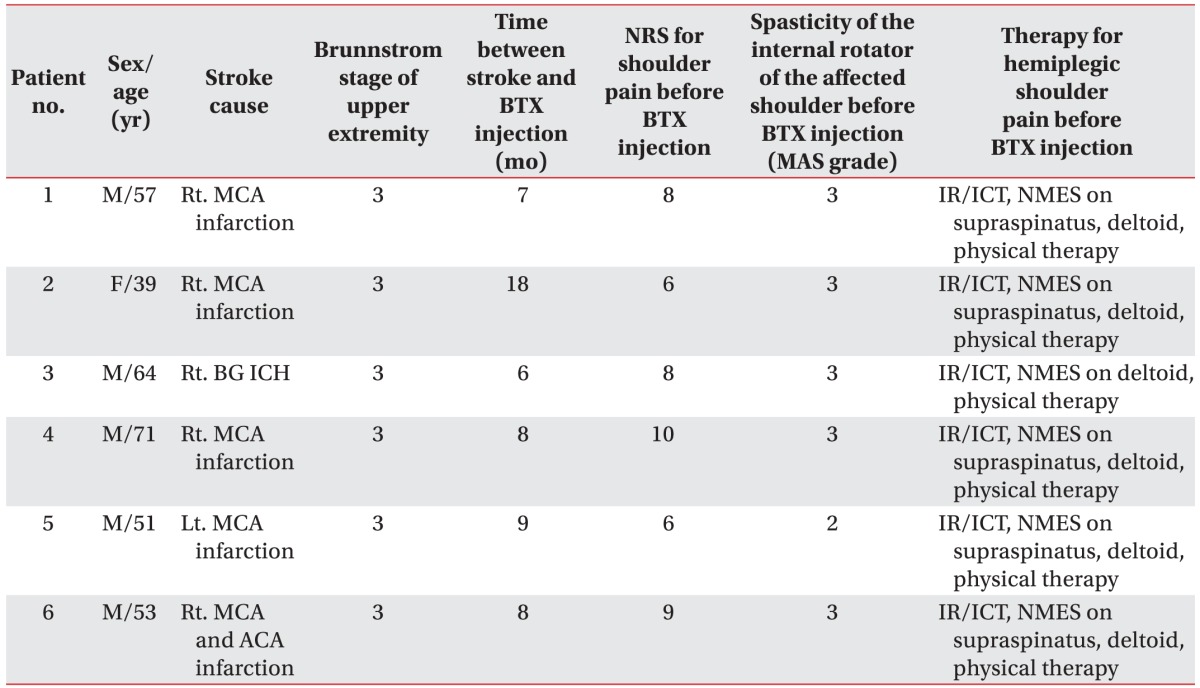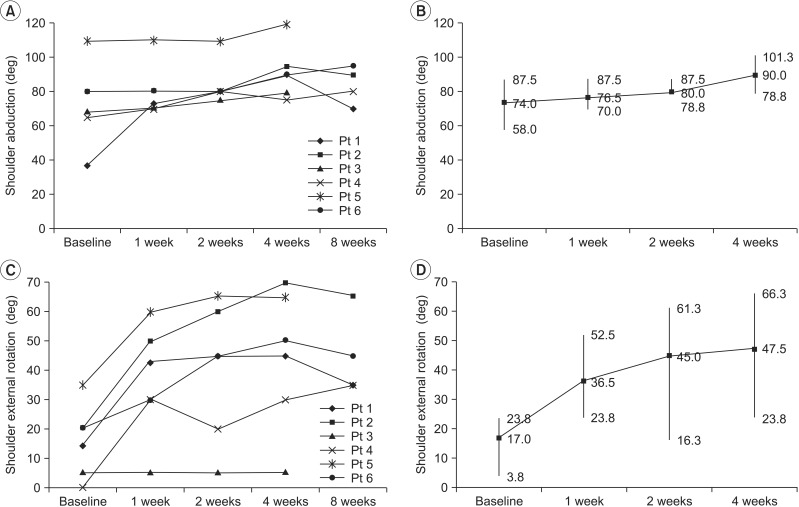1. Adey-Wakeling Z, Arima H, Crotty M, Leyden J, Kleinig T, Anderson CS, et al. Incidence and associations of hemiplegic shoulder pain poststroke: prospective population-based study. Arch Phys Med Rehabil. 2015; 96:241–247. PMID:
25264111.
2. Aras MD, Gokkaya NK, Comert D, Kaya A, Cakci A. Shoulder pain in hemiplegia: results from a national rehabilitation hospital in Turkey. Am J Phys Med Rehabil. 2004; 83:713–719. PMID:
15314536.
3. Lo SF, Chen SY, Lin HC, Jim YF, Meng NH, Kao MJ. Arthrographic and clinical findings in patients with hemiplegic shoulder pain. Arch Phys Med Rehabil. 2003; 84:1786–1791. PMID:
14669184.
4. Tavora DG, Gama RL, Bomfim RC, Nakayama M, Silva CE. MRI findings in the painful hemiplegic shoulder. Clin Radiol. 2010; 65:789–794. PMID:
20797464.
5. Murie-Fernandez M, Carmona Iragui M, Gnanakumar V, Meyer M, Foley N, Teasell R. Painful hemiplegic shoulder in stroke patients: causes and management. Neurologia. 2012; 27:234–244. PMID:
21514698.
6. Snels IA, Beckerman H, Lankhorst GJ, Bouter LM. Treatment of hemiplegic shoulder pain in the Netherlands: results of a national survey. Clin Rehabil. 2000; 14:20–27. PMID:
10688341.

7. Gamble GE, Barberan E, Laasch HU, Bowsher D, Tyrrell PJ, Jones AK. Poststroke shoulder pain: a prospective study of the association and risk factors in 152 patients from a consecutive cohort of 205 patients presenting with stroke. Eur J Pain. 2002; 6:467–474. PMID:
12413435.

8. Singh JA, Mahowald ML, Noorbaloochi S. Intra-articular botulinum toxin A for refractory shoulder pain: a randomized, double-blinded, placebo-controlled trial. Transl Res. 2009; 153:205–216. PMID:
19375681.

9. Roosink M, Renzenbrink GJ, Buitenweg JR, Van Dongen RT, Geurts AC, IJzerman MJ. Persistent shoulder pain in the first 6 months after stroke: results of a prospective cohort study. Arch Phys Med Rehabil. 2011; 92:1139–1145. PMID:
21704795.

10. Jankovic J. Botulinum toxin in clinical practice. J Neurol Neurosurg Psychiatry. 2004; 75:951–957. PMID:
15201348.

11. Lee HS, Oh HS, Shin JH. Paroxysmal autonomic instability with dystonia managed using chemodenervation including alcohol neurolysis and botulinum toxin type a injection: a case report. Ann Rehabil Med. 2015; 39:308–312. PMID:
25932429.

12. Yelnik AP, Colle FM, Bonan IV, Vicaut E. Treatment of shoulder pain in spastic hemiplegia by reducing spasticity of the subscapular muscle: a randomised, double blind, placebo controlled study of botulinum toxin A. J Neurol Neurosurg Psychiatry. 2007; 78:845–848. PMID:
17088333.

13. Jabbari B. Botulinum neurotoxins in the treatment of refractory pain. Nat Clin Pract Neurol. 2008; 4:676–685. PMID:
19043424.

14. Wissel J, Muller J, Dressnandt J, Heinen F, Naumann M, Topka H, et al. Management of spasticity associated pain with botulinum toxin A. J Pain Symptom Manage. 2000; 20:44–49. PMID:
10946168.

15. Wu T, Fu Y, Song HX, Ye Y, Dong Y, Li JH. Effectiveness of botulinum toxin for shoulder pain treatment : a systematic review and meta-analysis. Arch Phys Med Rehabil. 2015; 96:2214–2220. PMID:
26189200.
16. de Boer KS, Arwert HJ, de Groot JH, Meskers CG, Mishre AD, Arendzen JH. Shoulder pain and external rotation in spastic hemiplegia do not improve by injection of botulinum toxin A into the subscapular muscle. J Neurol Neurosurg Psychiatry. 2008; 79:581–583. PMID:
18408090.

17. Lim JY, Koh JH, Paik NJ. Intramuscular botulinum toxin-A reduces hemiplegic shoulder pain: a randomized, double-blind, comparative study versus intraarticular triamcinolone acetonide. Stroke. 2008; 39:126–131. PMID:
18048857.
18. Harden RN, Bruehl S, Stanton-Hicks M, Wilson PR. Proposed new diagnostic criteria for complex regional pain syndrome. Pain Med. 2007; 8:326–331. PMID:
17610454.

19. Klit H, Finnerup NB, Jensen TS. Central post-stroke pain: clinical characteristics, pathophysiology, and management. Lancet Neurol. 2009; 8:857–868. PMID:
19679277.

20. Yelnik AP, Colle FM, Bonan IV. Treatment of pain and limited movement of the shoulder in hemiplegic patients with botulinum toxin A in the subscapular muscle. Eur Neurol. 2003; 50:91–93. PMID:
12944713.

21. Rha DW, Han SH, Kim HJ, Won SY, Lee SC. Ultrasound-guided lateral approach for needle insertion into the subscapularis for treatment of spasticity. Arch Phys Med Rehabil. 2012; 93:1147–1152. PMID:
22503934.

22. Chang YW, Hughes RE, Su FC, Itoi E, An KN. Prediction of muscle force involved in shoulder internal rotation. J Shoulder Elbow Surg. 2000; 9:188–195. PMID:
10888162.

23. Hecht JS. Subscapular nerve block in the painful hemiplegic shoulder. Arch Phys Med Rehabil. 1992; 73:1036–1039. PMID:
1444768.
24. Braun RM, West F, Mooney V, Nickel VL, Roper B, Caldwell C. Surgical treatment of the painful shoulder contracture in the stroke patient. J Bone Joint Surg Am. 1971; 53:1307–1312. PMID:
5114694.

25. Mense S. Neurobiological basis for the use of botulinum toxin in pain therapy. J Neurol. 2004; 251(Suppl 1):I1–I7. PMID:
14991335.

26. Jabbari B, Machado D. Treatment of refractory pain with botulinum toxins: an evidence-based review. Pain Med. 2011; 12:1594–1606. PMID:
21958302.
27. Cosgrove AP, Corry IS, Graham HK. Botulinum toxin in the management of the lower limb in cerebral palsy. Dev Med Child Neurol. 1994; 36:386–396. PMID:
8168657.

28. Childers MK, Brashear A, Jozefczyk P, Reding M, Alexander D, Good D, et al. Dose-dependent response to intramuscular botulinum toxin type A for upper-limb spasticity in patients after a stroke. Arch Phys Med Rehabil. 2004; 85:1063–1069. PMID:
15241751.

29. Angaut-Petit D, Molgo J, Comella JX, Faille L, Tabti N. Terminal sprouting in mouse neuromuscular junctions poisoned with botulinum type A toxin: morphological and electrophysiological features. Neuroscience. 1990; 37:799–808. PMID:
1701041.

30. Marco E, Duarte E, Vila J, Tejero M, Guillen A, Boza R, et al. Is botulinum toxin type A effective in the treatment of spastic shoulder pain in patients after stroke? A double-blind randomized clinical trial. J Rehabil Med. 2007; 39:440–447. PMID:
17624477.









 PDF
PDF ePub
ePub Citation
Citation Print
Print



 XML Download
XML Download